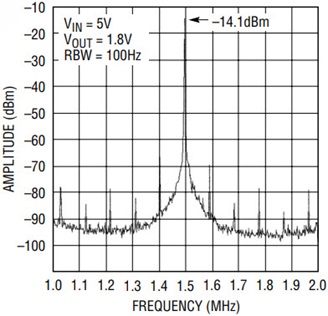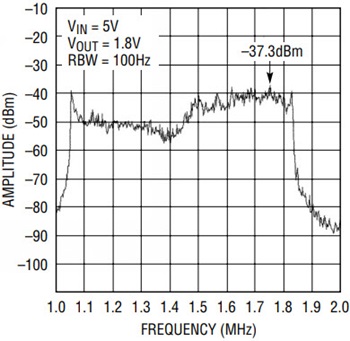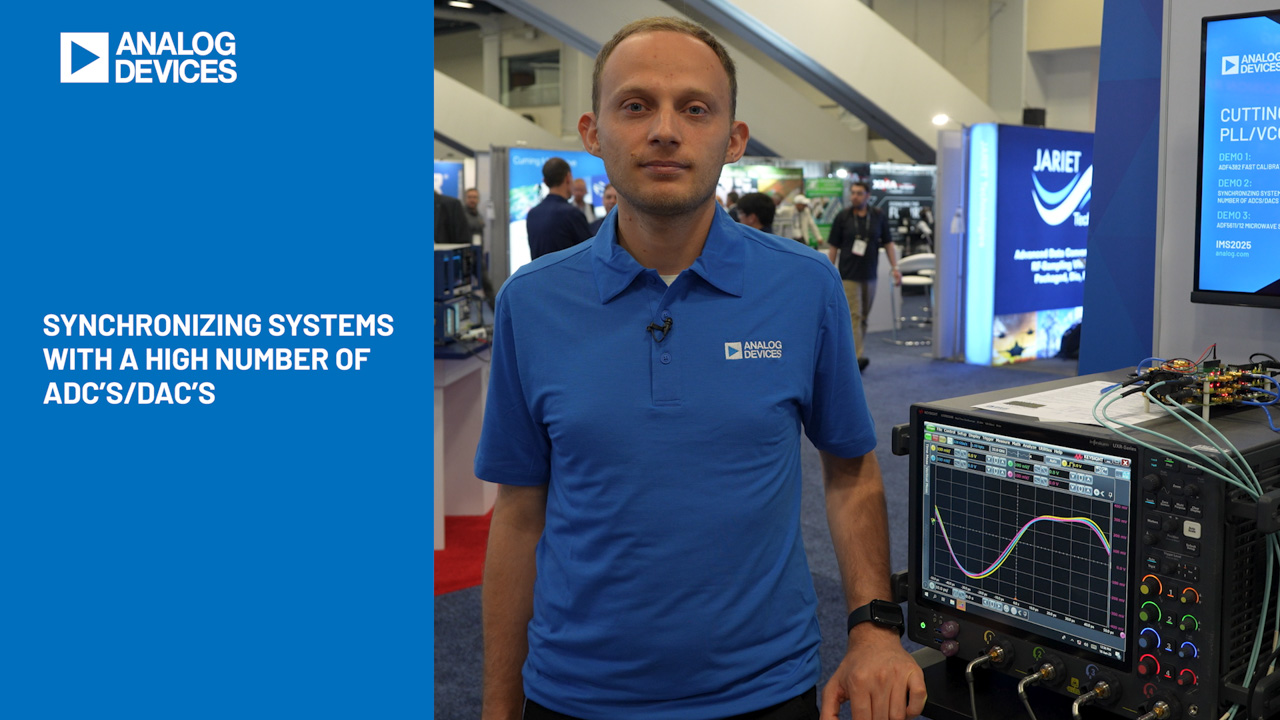Cascadable, 7A Point-of-Load Monolithic Buck Converter
Introduction
Easy-to-use and compact point-of-load power supplies are necessary in systems with widely distributed, high current, low voltage loads. The LTC3415 provides a compact, simple, complete and versatile solution. It includes a pair of integrated complementary power MOSFETs (32mΩ top and 25mΩ bottom) and requires no external sense resistor. A complete design involves choosing an inductor and input/output capacitors, and that’s it. The result is a fast, constant frequency, current mode, 7A DC/DC switching regulator.
Features
The overall solution is extremely compact since the LTC3415’s QFN 5mm × 7mm package footprint is small while its high operating frequency of 1.5MHz allows the use of small low profile surface mount inductors and ceramic capacitors. For loads higher than 7A, multiple LTC3415s can be cascaded to share the load while running mutually antiphase, which reduces overall ripple at both the input and the output. Other features include:
- Spread spectrum operation to reduce system noise,
- Output tracking for controlled VOUT ramp-up and ramp-down,
- Output margining for easy system stress testing,
- Burst Mode® operation to lower quiescent current and boost efficiency during low loads,
- Low shutdown current of less than 1μA,
- 100% duty-cycle for low drop out operation, phase-lock-loop to allow frequency synchronization of ±50%,
- Easily cascadable for multi-device load sharing with multiphase operation
- Internal or external ITH compensation for either ease of use or loop optimization.
Operation
Figure 1 shows a typical application of the LTC3415 in a 3.3V to 1.8V/7A step down converter. Figure 2 shows its efficiency and power loss vs load current. Figure 3 shows its transient response to a 5A load.

Figure 1. Typical application of the LTC3415 in a 3.3V to 1.8V/7A step down converter.

Figure 2. Efficiency and power loss vs load current for the circuit in Figure 1.

Figure 3. Transient response to a 5A load for the circuit in Figure 1.
The LTC3415 uses a constant frequency, current mode architecture to drive an integrated pair of complementary power MOSFETs. An internal oscillator sets the 1.5MHz operating frequency of the device. The main P-channel power MOSFET turns on with every oscillator cycle and turns off when the internal current comparator trips, indicating that the inductor current has reached a level set by the ITH pin. An internal error amplifier, in turn, drives the ITH pin by monitoring the output voltage through an external resistive divider connected to the VFB pin. While the P-channel power MOSFET is off, the internal synchronous N-channel power MOSFET turns on until ether the inductor current starts to reverse, as indicated by the SW pins going below ground, or until the beginning of the next cycle.
Modes of Operation: Burst, Pulse-Skip, and Forced Continuous
Three modes of operation can be selected through the MODE pin. Tying it to VIN enables Burst Mode operation for highest efficiency. During low output loads, the peak inductor current limit is clamped to about a quarter of the maximum value and the ITH pin is monitored to determine whether the device will go into a power-saving Sleep mode. Quiescent current is reduced to 450μA in Burst Mode operation because most of the internal circuitry is turned off.
For applications that aim to reduce output ripple and strive to maximize operating time at constant frequency, pulse-skip mode is a good solution. Pulse-skip mode is enabled by letting the Mode pin float or tying it to VIN/2 or VOUT. Inductor current is still not allowed to reverse as in Burst Mode operation, but the peak inductor current limit is no longer clamped internally. ITH has full control of output current until ITH drops so low (at low output loads) that minimum on-time of the device is reached and the LTC3415 begins to skip cycles.
For applications that require constant frequency operation even at no load, the LTC3415 can be put into forced continuous mode operation by tying the Mode pin to ground. In this mode, inductor current is allowed to reverse while the internal power MOSFETs are always driven at the same frequency.
Output Tracking
For applications that require controlled output voltage tracking between their various outputs in order to prevent excessive current draw or even latch-up during turn-on and turn-off, the LTC3415 includes a Track pin that allows the user to program how its output voltage ramps during start-up and shutdown. During start-up, if the voltage on the Track pin is less than 0.57V, the feedback voltage regulates to this tracking voltage, thus programming the output voltage to follow along. Inductor current is not allowed to reverse during tracking, ensuring monotonic voltage rise. When the tracking voltage exceeds 0.57V, tracking is disabled and the feedback voltage regulates to the internal reference voltage (0.596V). In other words, output voltage is controlled by the Track voltage until the output is in regulation.
Taking the LTC3415’s Run pin to below 1.5V would normally shut down the part, but if the output also needs tracking during shutdown, then the LTC3415 must remain active even if the Run pin is low. So, during shutdown, if Track is 0.5V or more below SVIN, then even if Run is low, the LTC3415 will not shutdown until Track has fallen below 0.18V, thus allowing the output to properly track the master voltage during its ramp-down. For applications that do not require tracking or externally controlled soft start, simply tie the Track pin to SVIN.
Output Margining
For convenient and accurate system stress test on the LTC3415’s output, the user can program the LTC3415’s output to ±5, ±10, and ±15% of its nominal operational voltage. The MGN pin, when left floating, forces normal operation. When MGN is tied to GND, it forces negative margining, in which the output voltage is below the regulation point. When MGN is tied to SVIN, then the output voltage is forced to above the regulation point. The amount of output voltage margining is determined by the BSEL pin. When BSEL is low, it’s 5%. When BSEL is high, it’s 10%. When BSEL is left floating, margin percentage is 15%. To prevent system glitches while margining, the internal output overvoltage and undervoltage comparators are disabled and thus PGOOD remains pulled high by the external resistor.
Multiphase Operation
For output loads that demand more than 7A of current, multiple LTC3415s can be cascaded to run out of phase while equally sharing output load current. Figure 4 shows a dual-phase single output 3.3V to 1.8V 14A application using two LTC3415s running 180° out of phase with respect to each other. Figure 5 shows the combined efficiency of 1-phase, 2-phase, 3-phase, 4-phase, and 6-phase operation.

Figure 4. Dual-phase single output 3.3V to 1.8V 15A application using two LTC3415s running 180° out of phase with respect to each other.

Figure 5. Combined efficiency of load sharing in 1-phase, 2-phase, 3-phase, 4-phase, and 6-phase operation.
The CLKIN pin allows the LTC3415 to synchronize to an external frequency (between 0.75Mhz and 2.25Mhz) and the internal phase-lock-loop allows the LTC3415 to lock on to CLKIN’s phase as well. The CLKOUT signal can be connected to the CLKIN pin of the following LTC3415 stage to line up both the frequency and the phase of the entire system. Tying the PHMODE pin to SVIN, SGND, or SVIN/2 (floating) respectively generates a phase difference (between CLKIN and CLKOUT) of 180°, 120°, or 90°, which respectively corresponds to 2-phase, 3-phase, or 4-phase operation. A total of 12 phases can be programmed by setting the PHMODE pin of each phase to different levels. For instance, a slave stage that’s 180° out of phase from the master can generate a 120° CLKOUT signal that’s 300° (PHMODE = SGND) away from the master for the next stage, which then can generate a CLKOUT signal that’s 420°, or 60° (PHMODE = SVIN/2) away from the master for its following stage. See Figure 6.

Figure 6. Cascaded, 12-phase operation makes for efficient high current load sharing.
A multiphase power supply significantly reduces the amount of ripple current in both the input and output capacitors. The RMS input ripple current is divided by, and the effective ripple frequency is multiplied by, the number of phases used (assuming that the input voltage is greater than the number of phases used times the output voltage). The output ripple amplitude is also reduced by, and the effective ripple frequency is increased by, the number of phases used.
Output Current Sharing
When multiple LTC3415s are cascaded to drive a common load, accurate output current sharing is essential to achieve optimal performance and efficiency. Otherwise, if one stage is delivering more current than another, then the temperature between the two stages is different, and that can translate into higher switch RDS(ON), lower efficiency, and higher RMS ripple. Each LTC3415 has a trimmed peak current limit such that when the ITH pins of multiple LTC3415s are tied together, the amount of output current delivered from each LTC3415 is nearly the same.
Different ground potentials among LTC3415 stages, caused by physical distances and switching noises, could cause an offset to the absolute ITH value seen by each stage. To ensure that the ground level doesn’t affect the ITH value, the LTC3415 uses a differential amplifier that takes as input not just the ITH pin, but also the ITHM pin, which doesn’t connect to any other circuitry except for the ITH differential amplifier. Therefore, the ITHM pins of all the LTC3415 stages should be tied together and then connected to the SGND pin at only one point.
Internal/External ITH Compensation
During single phase operation, the user can simplify the compensation of the internal error amplifier loop (on the ITH pin) by tying it to SVIN to enable internal compensation, which connects an internal 50k resistor in series with a 50pF cap to the internal ITH compensation point. This is a trade-off for simplicity and ease of use at the expense of OPTI-LOOP® optimization, where external ITH components can be selected to optimize the loop transient response with minimum output capacitance.
In multi-phase operation where all the ITH pins of each phase are tied together to achieve accurate load sharing, internal ITH compensation is disabled and external compensation components need to be properly selected for optimal transient response and stable operation.
Master/Slave Operation
In multiphase single-output operation, the user has the option to run in multi-master mode where all the FB, ITH, and output pins of the stages are tied to each other. All the error amplifiers are effectively operating in parallel and the total transconductance (gm) of the system is increased by the number of stages. The ITH value, which dictates how much current is delivered to the load from each stage, is averaged and smoothed out by the external ITH compensation components. Nevertheless, in certain applications, the resulting higher gm from multiple 3415s can make the system loop harder to compensate; in this case, the user can choose an alternative mode of operation.
The second mode of operation is single-master operation where only the error amplifier of the master stage is used while the error amplifiers of the other stages (slaves) are disabled. The slave’s error amplifier is disabled by tying its FB pin to SVIN, which also disables the internal overvoltage comparator and power-good indicator. The master’s error amplifier senses the output through its FB pin and drives the ITH pins of all the stages. To account for ground voltage differences among the stages, the user should tie all ITHM pins together and then tie it to the master’s signal ground. As a result, not only is it easier to do loop compensation, this single-master operation should also provide for more accurate current sharing among stages because it prevents the error amplifer’s output (ITH) of each stage from interfering with that of another stage.
Spread Spectrum Operation
Switching regulators can be troublesome where electromagnetic interference (EMI) is a concern. Switching regulators operate on a cycle-by-cycle basis to transfer power to an output. In most cases, the frequency of operation is fixed or is a constant based on the output load. This method of conversion creates large components of noise at the frequency of operation (fundamental) and multiples of the operating frequency (harmonics).
To reduce this noise, the LTC3415 can run in spread spectrum operation by tying the CLKIN pin to SVIN. In spread spectrum operation, the LTC3415’s internal oscillator is designed to produce a clock pulse whose period is random on a cycle-by-cycle basis but fixed between 60% and 140% of the nominal frequency. This has the benefit of spreading the switching noise over a range of frequencies, thus significantly reducing the peak noise. Figures 7a and 7b show how the spread spectrum feature of the LTC3415 significantly reduces the peak harmonic noise vs free-running constant frequency operation. Spread spectrum operation is disabled if CLKIN is tied to ground or if it’s driven by an external frequency synchronization signal.

a. The LTC3415’s output noise spectrum analysis in free-running constant frequency operation.

b. The LTC3415’s output noise spectrum analysis in spread spectrum operation.
Figure 7. Spread spectrum operation reduces EMI peaks by spreading the EMI energy over a range of frequencies.
Conclusion
With its many operational features and compact total solution size, the LTC3415 is an ideal fit for today’s point-of-load power supplies. It also has the advantage of simple upgradeability: if the load requirement of a power supply increases, no need to dread the redesign of the whole system, just stack on another LTC3415 and keep going.




















